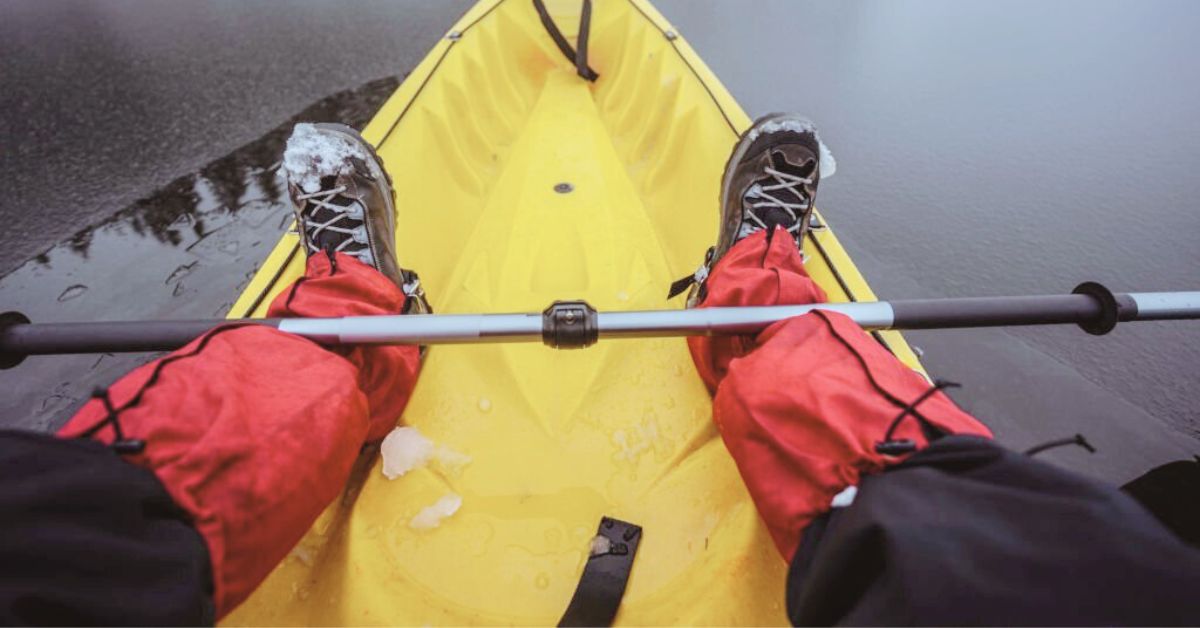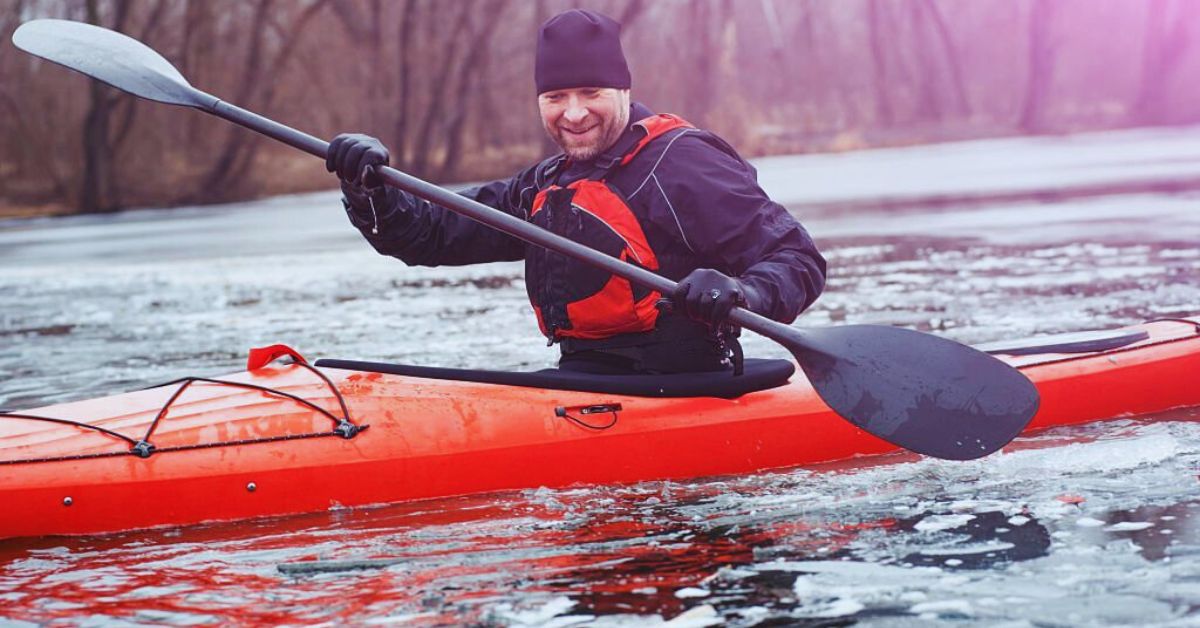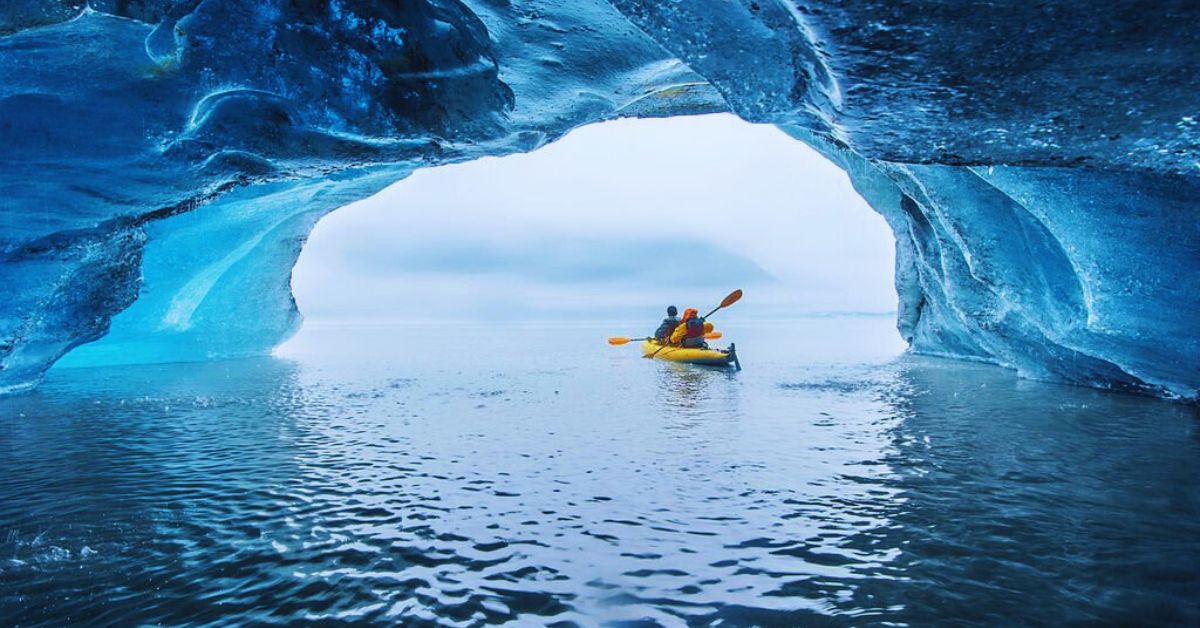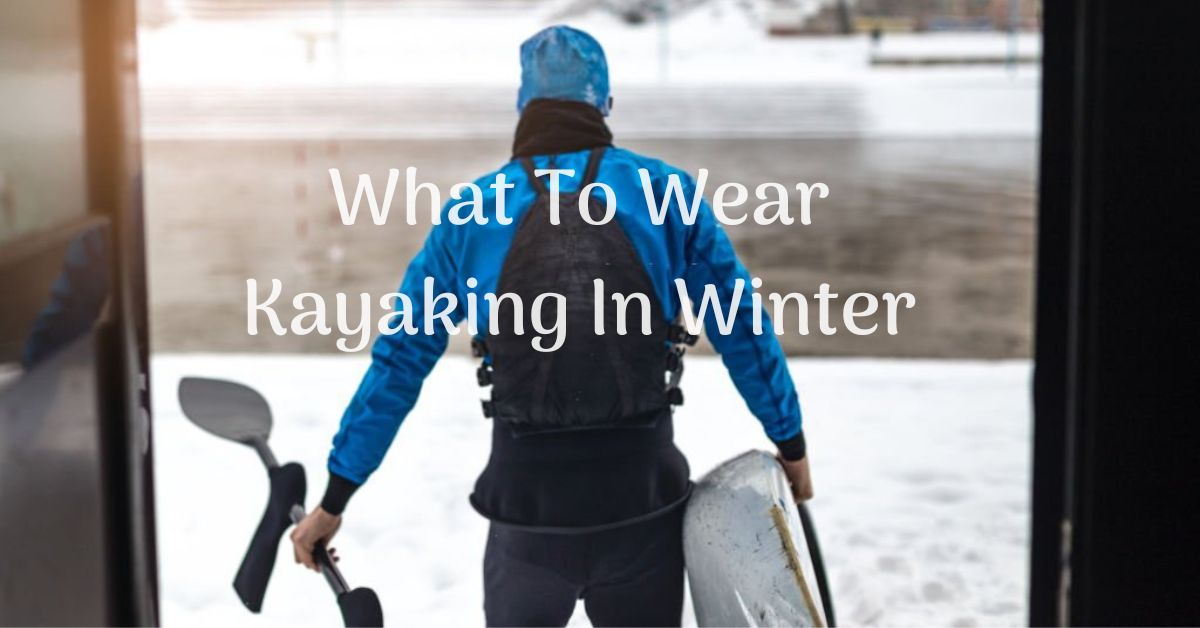Many wintertime kayakers appreciate the outdoors. Winter kayaking is difficult owing to the cold. Enjoying the activity requires being warm and comfortable. Stay warm, safe, and fashionable when kayaking with the correct gear.
This blog article contains the What To Wear Kayaking In Winter. We’ll cover everything from kayaking attire to cold-weather survival. This advice will help you dress warmly and stylishly for winter kayaking, whether you’re a novice or an expert.
Table of Contents
1. Introduction: The thrill of winter kayaking and the importance of proper attire
Winter kayaking is a thrilling way to explore ice rivers and snowy scenery. The fresh air, quiet, and unique difficulties of winter navigation make it an unforgettable journey.
Winter kayaking demands more than basic abilities and gear. An important factor is your outfit. Extreme cold requires proper clothes for comfort and safety. The correct clothing can keep you warm, protect you from the weather, and make your trip pleasurable.
You need the correct gear to kayak in the winter paradise. This complete guide to winter kayaking clothing will keep you warm, dry, and fashionable on your snowy adventures.
We will discuss insulating layers and waterproof apparel to keep you warm and safe from cold winds and water. We’ll also discuss how correct footwear, helmet, and accessories may improve your swimming experience.
Whether you’re a seasoned kayaker or a newbie on your first winter voyage, this guide will help you pick the correct gear. Let’s explore ways to keep warm and elegant while enjoying winter kayaking.
2. Understanding the challenges of winter kayaking: Cold temperatures, wind, and water
Winter kayaking is thrilling and memorable, but you must recognize the obstacles. Cold temperatures, cutting winds, and freezing seas offer distinct threats that demand cautious preparation and gear.
Cold temperatures
First and foremost, unprotected cold may swiftly damage your body. Insulation and heat retention need layering.
Use a moisture-wicking base layer to keep perspiration away and a thermal mid-layer for warmth. A waterproof and windproof outer layer will protect you and prevent heat loss.
Wind
The wind is also important. Wind chill can make even quiet days seem colder. To defend against wind and water, get a well-fitting, insulated paddling jacket or drysuit.
Remember to cover your extremities. Insulating gloves, a beanie or helmet, and waterproof socks will keep your hands, head, and feet warm.
Water
Perhaps the biggest problem of winter kayaking is freezing water. A flotation device is vital since falling into frigid water may cause hypothermia in minutes.
Choose a well-fitting, Coast Guard-approved cold-water PFD. Consider donning a wetsuit or drysuit for insulation and buoyancy in case of an unexpected immersion.
A safe and pleasurable winter kayaking adventure requires understanding and preparing for its obstacles. You can remain warm, fashionable, and ready for the winter paradise on the lake by dressing properly and buying the necessary gear.
3. Layering system: The key to staying warm and comfortable
Winter kayaking requires the correct gear to be comfortable and fun. Mastering layering is crucial to remaining warm and comfortable.
Outdoor enthusiasts layer to control body temperature and manage moisture. You may simply alter your insulation levels while kayaking by wearing different layers.

The basal layer manages moisture. It should be composed of merino wool or synthetic fibers that dry quickly. This layer pulls perspiration away from your body, keeping you dry and avoiding chills.
The middle layer traps body heat, warming it. This layer is ideal for fleece coats or synthetic insulation, which are warm and lightweight. Consider a mid-layer with zippered vents for temperature management.
Finally, the outer shell protects against wind, rain, and splashes. Protect yourself with a waterproof and windproof kayaking jacket or drysuit. To keep water out, make sure the outer layer has adjustable cuffs, a high collar, and a good fit.
But layering goes beyond clothes. Layer your accessories too. Thermal socks, waterproof gloves or mittens, and a fleece beanie or cap may keep your extremities warm as they grow chilly.
Remember that layering requires adaptability. As your body temperature changes while paddling, you may simply add or remove layers for comfort. It’s better to start with more layers and remove them than to shiver in little insulation.
Master layering to keep warm, dry, and elegant when kayaking in winter. Avoid letting the cold stop you from enjoying your favorite water activity. Even in the winter, you can enjoy kayaking with the correct gear.
4. Base layer essentials: Moisture-wicking and insulating materials
In winter kayaking, being warm and dry is essential for safety. Choosing the correct foundation layer is crucial. The base layer insulates and wicks sweat to keep you comfortable while kayaking.
Moisture-wicking
Choose moisture-wicking base layers like merino wool or polyester or nylon. Materials that draw moisture from your skin keep you dry and reduce sweating. These foundation layers control body temperature by preventing moisture, keeping you comfortable in damp weather.
Insulating materials
Insulation is another important component in winter kayaking base layer selection. Look for thermal base layers for added warmth. Merino wool base layers are very insulating. They create a comfortable microclimate by trapping heat around your body.
Additionally, consider tight base layers. A close-fitting base layer reduces airflow between your skin and the cloth, retaining heat better. The base layer should not be overly tight, since it may hinder mobility and cause pain.
Base layers also need layering. To stay warm, layer up or down depending on the weather. Having several base layer thicknesses lets you dress for the weather and your activity level.
Remember, your base layer keeps you dry and warm during winter kayaking. Buy high-quality, moisture-wicking, and insulating gear to enjoy the water even in cold weather.
5. Mid-layer options: Adding warmth and insulation without sacrificing mobility
Winter kayaking requires the right blend of warmth and maneuverability. Where mid-layer possibilities come in. These adaptable clothes insulate and preserve body heat while enabling mobility.
A fleece jacket is a common winter kayaking mid-layer. Great insulation, fleece traps heat close to the body while allowing moisture to dissipate. Look for a lightweight, breathable fleece jacket to be warm without weighing you down.
A down or synthetic insulated vest is another wonderful mid-layer. Vests are great for core warmth without limiting arm mobility. These vests include insulation to control your body temperature even in the coldest weather. Choose a vest with a water-resistant or waterproof shell to avoid splashes and mild rain.
For greater versatility, choose a softshell jacket. For vigorous winter activities like kayaking, softshell jackets provide insulation and breathability. These jackets are water-resistant, windproof, and elastic for freedom of movement. Softshell jackets with fleece linings are warmer and more comfortable.
Note the value of layering. Layering lets you alter your clothes to weather and activities. Start with a moisture-wicking base layer to avoid sweating. A waterproof and windproof outer shell and mid-layer for insulation defend against the elements.
Stay warm and elegant when kayaking in winter by picking mid-layers that blend warmth and movement. To enjoy and stay safe winter kayaking, choose a fleece jacket, insulated vest, or softshell jacket with comfort, durability, and utility.
6. Outer layer considerations: Windproof, waterproof, and breathable outerwear
Winter kayaking requires the correct outer layer to keep warm, dry, and comfortable. Your outerwear protects you from wind, water, and snow. Here are some winter kayaking apparel concerns.

Windproof
First, choose windproof clothes. Shivering and unpleasant, the stinging cold wind may swiftly take body heat. Windproof jackets and trousers with a sturdy wind-resistant shell or a snug-fitting elastic cuff prevent cold air from entering.
Waterproof
Equally crucial is waterproofing. Your outer layer should resist splashes, rain, and snow. This keeps you dry and prevents freezing and discomfort. Kayak apparel should be waterproof and water-resistant.
Breathable Outerwear
In addition to windproof and waterproof, breathability is important. You don’t want to become hot and damp within your protective layer after kayaking. Breathable gear lets sweat and heat escape while protecting you from the elements. Ventilation zippers and breathable fabric technology do this.
Finally, examine outer layer fit and function. It should be comfortable and offer complete range of motion as kayaking demands fluidity. To guarantee a tight fit that may be changed to your tastes and weather, look for adjustable cuffs, hems, or hoods.
High-quality apparel that satisfies these windproof, waterproof, and breathable characteristics will keep you warm and dry and improve your winter kayaking experience. Wear the correct outer layer and enjoy winter kayaking with elegance.
7. Don’t forget about your extremities: Gloves, socks, and headwear
Winter kayaking requires keeping your core and extremities warm. We all know how chilly fingers, toes, and heads feel. The correct gloves, stockings, and helmet are essential for a comfortable and pleasurable winter kayaking experience.
Gloves
Kayaking in chilly weather requires special gloves. Waterproof, windproof, and insulated gloves keep hands warm and dry.
Choose gloves with a flexible, non-slip grip to manage your paddle in wet circumstances. Consider gloves with touchscreen capability to use your phone or other gadgets without taking them off.
Socks
Equally vital is foot warmth. Buy high-quality thermal socks for cold-weather outdoor activities. Look for socks composed of merino wool or synthetic fibers for insulation and moisture-wicking. Also consider socks with reinforced heel and toe cushioning for comfort and durability.
Headwear
Finally, remember headgear. A thick cap or beanie keeps your ears warm and protects them from the cold. Look for fleece or wool caps with good insulation.
Consider a thermal headband or neck gaiter that may be used as a cap, neck warmer, or face mask for added flexibility.
Remember to keep your extremities warm to maintain body temperature and avoid frostbite. High-quality gloves, stockings, and hat let you enjoy winter kayaking while being warm and fashionable.
8. Footwear options: Ensuring warmth and grip on slippery surfaces
Kayaking in winter requires proper footwear for warmth and grip on slippery areas. The appropriate footwear is crucial since your feet are one of the most sensitive body parts to cold and damp environments.
Neoprene booties are popular for winter kayaking. Even in cold water, these booties keep your feet toasty with their dense insulation.
They wrap tightly around your feet and ankles for comfort and security. The rough sole of neoprene boots provides exceptional traction on slippery areas, offering you stability and confidence when kayaking.
Waterproof hiking boots are another choice. To keep your feet dry, these boots usually include a Gore-Tex outer layer. Look for boots with a robust outsole that grips wet and slippery conditions. Choose boots with insulation or detachable inserts for increased warmth in inclement weather.
For lightweight and flexible options, water shoes or kayaking sandals are good. These sneakers are designed for water sports and are quick-drying and breathable. Water shoes with non-slip soles or rubber outsoles with traction patterns grip slippery surfaces.
Winter kayaking requires comfort, warmth, and grip regardless of footwear. Try on several brands and designs to discover the right fit for your foot. Consider insulation, waterproofing, and sole grip to keep your feet warm and safe in freezing waters.
9. Safety gear: PFDs, helmets, and other essentials
Winter kayaking safety is paramount. Along with dressed for the cold, you need the correct safety gear to kayak safely and enjoyably.

PFDs
A Personal Flotation Device is essential safety gear. All kayakers need this, regardless of season. PFDs are particularly more important in winter when the water is colder and conditions are harder. Find a kayaking-specific PFD with a tight fit to keep you afloat in an emergency.
Helmets
In addition to a PFD, a helmet is needed for whitewater and roughwater kayaking. A helmet protects your head from rocks and other items. Look for a water sports helmet that fits comfortably and is safe.
Waterproof first aid kits
Whistles, signaling devices, and waterproof first aid kits are also needed for winter kayaking. These goods may help in emergencies or unforeseen kayaking obstacles.
Safety gear should not be skimped on. Invest in high-quality, well-fitting gear from trusted companies for optimal safety and peace of mind on the water. Safety first, and you may enjoy winter kayaking with confidence.
10. Additional accessories: Hand warmers, neck gaiters, and more
The appropriate winter kayaking gear is essential for warmth and elegance. A waterproof jacket, insulated leggings, and thermal base layers are vital, but don’t ignore accessories that may offer comfort and protection from the cold.
Hand warmers
Hand warmers are essential for winter kayaking. These little heat packets fit into gloves or pockets to keep your hands warm in frigid waters. Hand warmers improve paddle grip and dexterity without compromising comfort.
Neck gaiters
A neck gaiter is another underappreciated device that may make a big impact. This cloth may be worn around your neck, pushed up to conceal your face, or as a headband or cap.
A neck gaiter shelters you from harsh wind and traps heat. Moisture-wicking gear will keep you dry and comfortable when kayaking.
Insulated socks, thermal gloves or mittens, and an ear-covering beanie or headgear may improve your winter kayaking experience. Extra insulation and protection for your extremities ensures no area of your body is chilled.
Warmth doesn’t mean abandoning style. Find accessories in colors and patterns that complement your taste and add flare to your winter kayaking gear. You can brave cold seas while being warm, comfortable, and fashionable with the correct gear.
11. Tips for maintaining your gear: Proper care and storage
Your kayaking gear needs proper maintenance and storage to last and operate well. Winter may be brutal on outdoor equipment, so maintaining it can save you money and keep it in good condition. Here are some winter kayaking gear maintenance and storage tips:
1. Clean and dry your gear after each kayaking excursion to eliminate grime, saltwater, and debris. Clean your kayak, paddle, and other gear with mild detergent and warm water. Prevent mold and mildew by drying them fully after cleaning.
2. Before storing your goods, check for wear and damage. Check your kayak for cracks, dents, loose straps, and other damage. Fixing these concerns quickly can avoid additional damage and prepare your gear for kayaking season.
3. Keep kayaking gear in a cool, dry, well-ventilated place. Not keeping it in direct sunlight or excessive temperatures might harm the materials. A storage rack or hooks may keep your kayak off the ground and prevent damage.
4. Protect your kayak and other equipment with covers or bags to prevent dust, wetness, and scratches. Your gear will stay in good condition with these coverings throughout winter.
5. Accessories: Don’t forget your life jacket, spray skirt, and dry bags. Carefully clean and dry them before keeping. Check zippers, buckles, and other fastenings and replace or repair as needed.
Follow these maintenance and storage guidelines to extend the life of your kayaking gear and prepare it for your next winter expedition. Remember that investing in maintenance now will help you to enjoy many more seasons of warm and elegant kayaking.
12. Wrapping Up: Enjoying winter with style and warmth
Winter kayaking may be enhanced by embracing the winter beauty while keeping warm and fashionable. You can swim in cold water while appearing stylish and comfortable with the correct gear.
This guide covers winter kayaking base layers, clothing, accessories, and footwear. Layering, insulation, moisture-wicking, and waterproof/windproof outerwear have been discussed.
Choose durable textiles like merino wool, fleece, and synthetic mixes to maintain heat and breathe. Use a drysuit or waterproof jacket and trousers pair for outer layers that are waterproof and breathable.
In winter kayaking, proper accessories are essential. Insulating hats, gloves, and neck gaiters help keep your extremities warm. Choose gloves with dexterity and grip to fully control your paddle.
Finally, fashionable winter clothing is powerful. No longer does pragmatism equal compromising flair. Brands today provide many stylish, useful solutions.
Find clothing that matches your style and keeps you warm and protected in brilliant colors, sleek designs, fashionable patterns, and flattering styles. Safety should always come first during winter kayaking. Preventing hypothermia and enjoying the water requires proper weather attire.
Gear up, enjoy winter, and create a stylish statement while exploring snowy landscapes with confidence. Winter kayaking is beautiful and may be made into lasting experiences with the appropriate gear and attitude.
